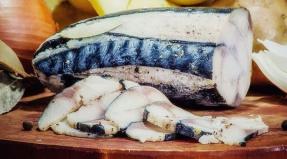Greek Salad - Recipes, History and Traditions of Mediterranean Cooking. Greek salad, classic recipe (5 step-by-step unusual recipes for Greek salad)
Before we start cooking, we will prepare a board on which we will cut, a sharp large knife, a salad bowl with high sides and a narrow bottom. If everything is clear with the board and the knife, then the choice of dishes is not obvious. The fact is that the narrow bottom and high walls of the container will allow excess juice from vegetables and dressing to drain freely, and coarsely chopped cucumbers and tomatoes will not cake and sour at the bottom.
Salting is better already on the plate, but in Greece this behavior can be regarded as disrespect and bad taste.
- Wash and dry vegetables. All vegetables must be rinsed well, as bacteria from the ground and fertilizers accumulate on the skin, which can accelerate the souring process of the salad and cause slight discomfort. For the same reason, vegetables should be dried on disposable paper towels, and not on cloth kitchen towels, with which the whole family wipes their hands together.
- Peel the cucumbers and peppers. It is customary to add peeled cucumbers to Greek salad. Firstly, it is tough, and secondly, it is in the peel that nitrates and other substances harmful to humans accumulate. Peppers must be cleaned of seeds and thin films on which they grew, as they can be very bitter.
- Chop the cucumbers. Cut the peeled cucumbers into rounds 7-9 mm thick and pour into a salad bowl. They go first, as they are denser than tomatoes and produce less juice.
- Chop the pepper. Cut sweet peppers into half rings 7-9 mm thick and pour into a salad bowl.
- Chop the tomatoes. Cut the tomatoes in half first. Carefully cut out the growth point of the twig in the form of a small triangle with a knife. Then we cut each half into 3-4 more slices, depending on the size of the fruit and put it in a salad bowl.
- Peel and chop the onion. Red sweet onions must be peeled well. Withered, dry or spoiled onion layers should not get into the dish. If the onion is very spicy, then it can be cut in half and put in salt water for a short time. Then we cut it into the thinnest possible half rings.
- Pour in the olives. Usually pitted olives are added to the dish. This is inconvenient and will force guests to be careful not to damage their teeth and jaw, since it is almost impossible to crunch a bone. Undoubtedly, you can use pitted olives, but according to Greek chefs, the taste will not be the same.
- Cut and lay out the feta. The cheese in a real Greek salad is never cut into small squares. Culinary customs require the feta to be cut into large chunks 10-15 mm thick. Then they are randomly placed on top of the vegetables.
- Pour the dressing over the salad. Shake the prepared and infused Greek salad sauce well and pour over all the products, so that it gets on the cheese, olives and vegetables.
It is in this form that the dish is served on the table in a large salad bowl. It is not stirred or salted before serving. If you add even a pinch of salt, then the vegetables will give juice, which will accumulate at the bottom, and the salad itself will become tasteless. It is better to salt directly on the plate, if there is an urgent need for it, but in Greece this behavior can be regarded as disrespect and bad form.
The real Greek salad is ready. Bon Appetit!
Composition of Greek salad
- tomatoes (medium) - 3 pieces;
- sweet green pepper (medium) - 1 piece;
- olives (black olives) - 10 pieces;
- cucumbers - 3 pieces;
- feta cheese - 300 grams;
- red onion - 1 head;
- dressing for Greek salad - 2 tablespoons.
How to choose foods for Greek salad
Vegetables
Greece is the country of the sea and the sun. Here vegetables can be grown all year round and most of the time outdoors, which is why Greek salad is especially tasty in its homeland. Traditionally, it was prepared from freshly picked vegetables ripened in the beds.
The human need for food has forced science to dramatically transform agricultural production. The massive task of feeding an ever-growing population of people has led to the fact that the quality of food has receded into the background compared to quantity.

Residents of large modern cities often do not even know the taste of cucumbers and tomatoes grown on the ground under the sun. And even more so, few people know that they have a bright aroma. Ground tomatoes and cucumbers are much tastier than greenhouse ones, and even more so than vegetables grown in hydroponics (a method of growing plants in a nutrient liquid medium without soil and natural light).
Real tomatoes should be red, dense, juicy, with a tomato flavor, and better with a green twig
A real Greek salad is best made with real vegetables. Tomatoes should be red or nearly red, firm, juicy, but not watery. Tomatoes should have a distinct tomato flavor. Sourness or complete absence means that the fruit is already spoiled or plucked unripe.
It is better to choose those fruits that are sold with a twig. It can always be used to determine the quality of the tomatoes. A ripe red vegetable and a dense green twig will confirm that it is ripe and recently picked.
The quality of the cucumber determines the condition of its skin. It should be firm without dents or yellow spots. It is these signs that often indicate an excess of nitrates. In Greek salad, it is better to use medium-sized cucumbers with pimples. They are tastier and less watery.

Red onions are one of the healthiest foods around, and are significantly healthier than regular white onions. Because it contains twice as many antioxidants to help fight inflammation. Recently, red onions have been replaced with white ones, for example, in the Mimosa salad recipe. According to the latest research, red onions contain substances that can help you lose weight.

The popularity of Greek salad all over the world has led to the demand for feta cheese. Almost all dairy companies began to try to produce it. Therefore, a few years ago, after a large trial, feta cheese received the status of "controlled origin". This means that only cheese produced in Greece can be called feta cheese.
Real feta can only be made in Greece
In Russia, manufacturers often use the name feta for products that have nothing to do with cheese, and sometimes even dairy products. The most common trick is to give the product a name that sounds similar to the name of the cheese: fetax, fetaki, etc.
Therefore, when buying, carefully read the composition: real feta should be made from sheep's milk, sometimes with the addition of goat's milk, and always in Greece. Everything else, whatever it is called, is not Greek cheese.

One of the facts about cheese is that the Greeks prepare not only salads with feta, but meat, sauces, mayonnaise and even bake muffins. Feta in a Greek salad recipe can be replaced with feta cheese. She, too, is prepared with the addition of sheep and goat milk, but on the basis of cow's milk. Cheese is usually denser and saltier.
Sometimes, in order to bring its taste closer to the taste of feta, feta cheese is soaked in ordinary cow's milk. For vegetarian or lean Greek salad, you can use soy tofu instead of feta. However, it is somehow difficult to name the dish resulting from such substitutions as Greek salad.

Due to its sour-salty taste and dense texture, feta makes ordinary cut vegetables a delicious salad. Feta is one of the few cheeses that can be stored for up to six months if it is in brine. However, without it, the shelf life is calculated in hours. This is something to keep in mind if you are planning to send ready-made Greek salad in the refrigerator for a day or two.
Olives (olives)
Olives are the fruits of the olive tree, which has been cultivated since ancient times for the production of olive oil. This name is used exclusively in Russian and other Slavic languages. The common name for these fruits is olives.
In many world religions, the olive is a symbol of peace, goodness and prosperity. The ancient peoples of the Mediterranean considered it an irreplaceable and extremely valuable plant. Olive oil, olives and bread have been the mainstay of the diet of the inhabitants of the region for several millennia.
In Russia, it is customary to distinguish olives and olives by color: some are green, others are black. In this connection, there is a misconception that green olives are unripe olives. In fact, olives and olives are ripe fruits harvested from different varieties of olive trees.

Olives are usually coarser, darker, and oily. They are used to obtain oil and are considered the most valuable. However, it is very difficult to find real black olives in the store. Most of the canned olives on the shelves are not sun-ripened or soaked in salted sea water for long periods of time to remove their natural bitterness.
At large industrial enterprises producing "mass product" olives are harvested slightly ripe, using chemical treatment to bring them to the desired degree of maturity, immersed in a solution containing a food additive - iron gluconate (E 579) and packed in sealed cans. Iron gluconate has a mild coloring effect, but is excellent for giving an even, glossy black color to olives.
Naturally black olives have an irregular dark brown color and a matte skin
Naturally black olives usually have an irregular dark brown color with a dull skin. They are preserved in glass containers, since there is no need to hide the color of the brine and the light will not affect the quality of the product in any way.
Olives tinted with iron gluconate are not in themselves dangerous if the proportion of the substance in the brine is observed. But their taste is far from real and they are not suitable for Greek salad.
Dressing for greek salad
The whole world is sure that it is enough to season a Greek salad with olive oil and some dry spices, that its preparation is no more difficult than a simple omelet. However, the Greek salad recipe suggests a more careful and flavorful selection of herbs and oils. The right flavors can turn common vegetables and cheese into a culinary art.


How the Greek salad recipe conquered the world
Summer salad of vegetables, vegetable oil and herbs has been known since the appearance of tomatoes and cucumbers in Europe. In most European countries, you can find a snack in which tomatoes, bell peppers, cucumbers, onions and herbs are mixed.
Olives and olive oil are indispensable ingredients in all dishes in the Mediterranean countries, with the possible exception of tea and ice cream. The Greek salad recipe owes its name not to the composition of vegetables, but to one single ingredient - feta cheese.
Feta is made from goat and sheep milk. All over the world this cheese is called Greek. Although the recipe for its preparation was known to the ancient Egyptians, Romans, Phoenicians, etc. In the Byzantine era, sheep's milk cheese was officially called "Prosphatos", which translates as "recent". In the 17th century, the name "Feta" was assigned to it, meaning "piece" or "hunk" in Italian.

For quite a long time, vegetables were cut into large pieces in a Greek salad so that it was convenient to eat them with your hands, dipping them into olive oil mixed with herbs in a separate container. Subsequently, the culture of eating changed and the use of cutlery became the norm, which led to a reduction in the size of the pieces and the addition of olive dressing directly to the dish.
The recipe for Greek salad has not changed over the centuries. When ordering it in the best restaurants, regardless of city, country or even continent, the Greek salad will be Greek. The only significant difference may be the way the dish is presented.
In the classic recipe, feta is cut into large thick chunks
In the classic version, feta is cut into large, thick slices, while the Central European standard suggests cutting cheese into small cubes. There is also a more original way: a piece of cheese is strung on a wooden skewer, followed by an olive, pieces of vegetables and placed in one large dish, pouring olive oil mixed with finely chopped herbs on top.
Several popular American health and wellness publications estimate that 20% of metropolitan residents choose to start their meals with Greek salad. In recent years, it has become the main international lunch dish.

Most nutritionists recommend consuming a salad during the day, as it contains a lot of substances that must be absorbed by the body before 6 pm. Despite all the difficulties associated with finding quality products, it has long been one of the most popular salads for the new year.
Chefs from leading restaurants claim that dressing plays an important role in the recipe for Greek salad. Properly blended herbs and olive oil give the dish an unforgettable aroma and flavor.
Greek salad is one of the best ways to prepare fresh vegetables. It turns out to be light, aromatic, but not trivial. This salad stands out among all other types for the presence of very tasty and thoughtful dressings. You can also change the amount and type of additional ingredients.
Collected here are the most detailed step-by-step recipes for classic Greek salads with the best dressings.
Greek salad - general principles of preparation
Vegetables for Greek salad are important to choose ripe, juicy, but not overripe. Cucumbers should not contain large seeds. If they have a thick skin and there is no way to replace it with another vegetable, then the skin is peeled. Tomatoes need red, but not soft, otherwise they will quickly lose their shape. Colored peppers are better than green peppers. Vegetables cannot be cut and seasoned in advance. Greek salad is best prepared before consumption. In an hour, it will lose its attractive and fresh appearance, the vegetables will float.
What products are used:
Vegetables (cucumbers, peppers, tomatoes, lettuce);
Olives;
Chees Feta;
Crackers.
Feta cheese is not always available in stores, but it can be replaced with feta cheese or other similar pickled types. Goat cheese, which is often found in bazaars, can diversify the classic Greek salad.
The main ingredient of the dressing is very often olive oil and it is very important that the bottle is labeled Extra virgin. Only a high-quality product will give the salad that special taste. But yogurt-based dressing options are often found, below there is a step-by-step recipe for such a Greek salad.
Greek salad: a classic step-by-step recipe with olive dressing
The classic Greek salad step-by-step recipe uses a traditional oil dressing with lemon juice. It perfectly complements the taste of vegetables, gives a wonderful aroma and piquant sourness.
Ingredients
Two large cucumbers;
One ripe pepper;
One salad onion;
100 g feta;
20 large black olives;
Half a lemon;
A couple of pinches of oregano (oregano popularly);
3 tbsp. l. oils;
Two tomatoes.
Preparation
1. Rinse all vegetables and wipe dry. Cut off the tips of cucumbers, cut first in half, then again and across in fairly large pieces. We make bars 1.5-2 centimeters. It will turn out to be cubes, you do not need to grind it. Pour into a bowl.
2. Cut the tomatoes in half, remove the attachment point with the stalk. Cut in half again, then cross each quarter. Large pieces will turn out. We choose dense vegetables so that the shape remains beautiful, the tomatoes do not wrinkle during the stirring process.
3. Cut the pepper in half first. Choose the middle with seeds, then cut it lengthwise and chop it across into strips, but not quite thinly. Pour into the main vegetables.
4. Peel the salad onion. Cut into thin rings. Disassemble the layers so that the vegetable is evenly distributed in the salad.
5. Squeeze the juice out of the lemon. This amount of vegetables will take about one and a half tablespoons. But the dressing must be matched to the taste of the tomatoes. If they are sour, then you can pour in less.
6. Combine olive oil with lemon juice, beat until smooth, add oregano.
7. Pepper the vegetables, lightly sprinkle with salt and pour out the dressing. Stir the salad gently. Usually, two spoons or scoops are used for this. With their help, the food is gently lifted from the bottom of the bowl and turned over.
8. Mixed salad can be laid out in a beautiful dish or immediately divided into portions.
9. Cut the feta cheese into neat cubes, you don't need to make it very coarsely, and put it on top in a chaotic manner.
10. Take pitted olives. They can be put whole in a salad or cut in half. But in the second case, we cut only along. We spread feta between cubes.
11. Greek salad according to the classic recipe is not decorated with herbs, but it will not be superfluous. If necessary, add a sprig of dill, parsley, or lay all the vegetables on top of lettuce.
Greek salad: a classic step-by-step recipe with a spicy dressing
Recipe with cherry tomatoes. If they are not there, then we replace them with ordinary tomatoes, we calculate the approximate amount, depending on the size. This step-by-step classic Greek salad recipe uses an incredibly tasty and flavorful dressing. Hot mustard is used for its preparation. If the sauce is not vigorous enough, then, if desired, increase the amount.
Ingredients
25 olives;
Two cucumbers;
A dozen cherry;
Half an onion;
Romaine lettuce leaves;
100 g of pickled cheese.
For refueling:
A couple of spoons of oil;
A spoonful of soybeans. sauce;
One spoonful of apples. vinegar;
0.3 tablespoons of mustard (spicy);
A little oregano;
Five grams of honey.
Preparation
1. This salad will be served on a platter lined with green lettuce leaves. It can be replaced with an iceberg, Beijing cabbage is often used, removing tough veins. We prepare the dish, lay out the leaves. If you like their taste, then you can cut and fill in as the first layer, it will be more convenient to eat.
2. Preparing the dressing. Mix apple cider vinegar, which can be replaced with lemon, with honey and mustard, grind thoroughly, add oregano, salt and all the other ingredients listed above. It is best to beat the dressing well, you can use a blender. Set aside, let the sauce infuse.
3. We wash and wipe dry the vegetables. Cut the cucumber into large pieces. If the skin is thick, it is better to remove it immediately. It is convenient to use a vegetable knife for this. Sometimes not all the skin is removed, but strips are made, alternating the white pulp with the green skin. It turns out very beautiful and unusual pieces. Transfer the prepared cucumber to prepared lettuce leaves.
4. Cut the cherry tomatoes into quarters or halves, as you like. If ordinary tomatoes are used, then cut them into neat pieces. Put it on top of the cucumbers.
5. Now we take the onion, cut off the half, we do not need the second part. Cut into half rings, disassemble with your hands, sprinkle cherry tomatoes on top. Sometimes onions are placed under them, that is, on cucumbers. It doesn't matter.
6. Now let's get down to cheese. It is always cut into neat cubes, laid out on vegetables.
7. Cut the olives into halves, place them between the pieces of cheese or simply sprinkle them casually.
8. In principle, the salad is ready. It remains only to sprinkle it with the previously prepared sauce, which has already stood. But sometimes the dressing is served in a separate gravy boat. This is convenient in that you can independently regulate its amount and the severity of the salad.
Greek salad: a classic step-by-step recipe with croutons and yogurt
A terrific dressing option for the tastiest filling. The step-by-step recipe for a classic Greek salad uses croutons. In no case do we take ready-made products from bags, we only cook ourselves.
Ingredients
Four tomatoes;
Three cucumbers;
Two peppers;
One head of lettuce onions;
Half a loaf;
160 grams of brine cheese;
100 g olives;
2 bunches of lettuce.
Yoghurt dressing:
100 g thick Greek yogurt
0.3 tablespoons of mustard;
A spoonful of lemon juice;
A spoonful of oil;
One clove of garlic;
0.3 tsp dried oregano;
Salt and soy sauce to taste.
Preparation
1. It is better to start the salad with croutons so that they have time to cool down. It is advisable to use yesterday's or the day before yesterday's loaf, that is, a little stale. Take a good knife and cut it into slices, then into small cubes. We spread on a baking sheet, send to the oven and cook until golden brown.
2. Take out the croutons, cool.
3. Now we will make the dressing so that it is infused. For the sauce, it is best to use thick yogurt, the fat content is arbitrary. Put it in a bowl, add chopped garlic, lemon juice, add a little dry oregano. You can take fresh chopped greens, then you need 2-3 branches. Put the mustard, you can pour in a little soy sauce or salt. Rub until smooth, set aside the dressing, let it infuse.
4. We are engaged in vegetables. Cut the cucumbers lengthwise into 6 pieces, then cut them into pieces across, make bars of 1.5-2 centimeters.
5. We spread lettuce leaves and pour cucumbers on them.
6. Now we cut the tomatoes, put them on top of the cucumbers. We do not make small pieces. Can be substituted with cherry tomatoes cut in half.
7. Cut the onion into half rings, sprinkle with vegetables.
8. Cut the cheese into cubes, the olives in half, add the croutons to them, stir together and send all this to a dish with cucumbers and tomatoes. In general, you can mix all the products with each other and put them on lettuce sheets, but the crackers from fresh vegetables quickly soften and then do not crunch.
9. Before serving, pour the Greek salad with a flavored yogurt-based dressing or offer it separately. This option is convenient if the appetizer needs to stand for a little time. It will not flow without refueling, it will retain its attractive appearance longer.
No sweet salad onions? You can chop a regular onion head, pour it into a colander and pour over boiling water. Another great option is to pickle the onions. It will turn out just chic! You need to cut the vegetable, add water acidified with vinegar, leave for half an hour. To soften the taste, sometimes a little vegetable oil and a pinch of sugar are added to the marinade.
Very often, meat products are added to Greek salads. Their choice will directly depend on the taste of the cheese. If it is salty, bright, then it is better to take fresh boiled chicken or turkey. If the cheese is bland and tasteless, then beef or pork will help ennoble the dish.
Lovers of salads with bright flavors can add some pickled or salted mushrooms. They will complement fresh vegetables, give the dish their own flavor.
In Greece, this salad is prepared from fresh vegetables, coarsely chopped, with the addition of feta cheese and olive oil. This is an unusually tasty, aromatic and light salad. The key to success is fresh vegetables and large olives with pits, oregano and real olive oil.
Greek salad is loved all over the world, it is usually served in a classic form, and is rarely improvised with the ingredients. The changes affect only the components of the dressing, for example, some add cloves of garlic to the dressing. Salad preparation may differ in the way you cut vegetables, one thing remains unnamed - the cutting should be coarse. Depending on the place of preparation, chicken breast, mushrooms, shrimps or other seafood can be added to the salad.
By the way, in Greece itself, this salad is called rustic.
Greek salad classic
Ingredients:
- Fresh ripe tomatoes - 3 pcs.,
- Cucumbers (small) - 3 pcs.,
- Salad onion (red) - 1 pc.,
- Olives (large with pits) - 1 jar (or 300 g),
- Feta cheese - 180 g,
- Oregano (dry) - 0.5 tsp,
- Olive oil - 50-70 ml,
- Ground black pepper,
- Salt.
Preparation:
Cut the prepared tomatoes and cucumbers into large pieces. Put in a salad bowl. Peel the onion and cut into thin rings. Add to cucumbers and tomatoes. Place olives and diced feta cheese on the onion. Sprinkle with dry oregano, salt and pepper. Pour olive oil over the salad. Can be served without stirring.
Greek salad according to the classic recipe
“Classic Greek Salad one of the most delicious salads. The composition of the Greek salad includes a set of fresh vegetables and herbs, as well as olives and feta cheese, (fetax) or feta cheese. Dressing for "Greek salad" serves olive oil (preferably the first cold pressing), lemon juice, salt, spices.
The salad always turns out colorful and noticeably refreshes the table. The combination of light and flavorful ingredients is very harmonious. "Greek salad" is ideal for any holiday, and especially for the New Year, because it is in the winter time that you want something fresh.Made from fresh vegetables, this salad will bring a touch of freshness both to the dinner table and to a festive banquet!
The recipe for the "Greek" salad according to the classic recipe
Ingredients:
- Cucumbers (medium size) - 2 pieces;
- Cherry tomatoes - 10 pieces;
- Olives (pitted) - 80 grams;
- Fetax cheese (feta or feta cheese) - 200 grams;
- Red bell pepper - 1 piece;
- Red onion - 1 onion;
- Lettuce leaves - 1 bunch;
For the sauce:
- Olive oil - 5 tbsp. spoons;
- Lemon - 1 piece;
- Salt and pepper to taste.
Salad preparation:
First of all, all vegetables will need to be washed and dried. Clean and dried vegetables will need to be chopped coarsely.
Step 1. Cut the cherry tomatoes into halves.
 1. Cut the cherry tomatoes in half
1. Cut the cherry tomatoes in half
Step 2. For cucumbers, cut off the tips on both sides. Cut into quarters and cut into large triangles. If the skin on the cucumber is too tough, peel it. I have thin-skinned cucumbers, so I use unpeeled cucumbers.
 2. Cut the cucumbers coarsely
2. Cut the cucumbers coarsely
Step 3. Peel the sweet red pepper from seeds and stalks. Cut into large strips and cut into cubes.
 3. Cut the red bell pepper into cubes
3. Cut the red bell pepper into cubes
Step 4. Peel and cut the red onion into thin half rings. If desired, you can cut it into cubes.
Red onions are sweeter and softer than onions, so red onions are recommended for the recipe. But in my case, I did not find a red onion, so I used onions. To remove the bitterness from the onion, pour boiling water over it and let the liquid drain. The version with white onions turned out to be very tasty too!
 4. Cut the onion into half rings
4. Cut the onion into half rings
Step 5. Feta cheese is an essential ingredient in Greek salad. It is a soft and salty cheese made from goat's or sheep's milk. In terms of consistency and taste, it is similar to feta cheese. In my salad, I used fetax cheese - it is similar to feta, only less crumbly. Regardless of which cheese you choose, it is placed in the salad in the form of cubes.
 5. Cut the cheese into cubes
5. Cut the cheese into cubes
Sauce preparation:
We will prepare the sauce from olive oil and lemon juice. You will also need salt and black pepper.
Step 1. Cut the lemon into two halves. We will squeeze juice out of one, and use the other at your discretion.
 1. Olive oil and lemon
1. Olive oil and lemon
Step 2. Pour oil (5 tablespoons) into a bowl and squeeze lemon juice (2 tablespoons), mix, salt and pepper to taste.
 2. Squeeze juice from half a lemon
2. Squeeze juice from half a lemon
We collect the salad:
Step 1. Put lettuce leaves on a roomy flat dish. Lettuce leaves must be washed and dried in advance.
 1. Spread the bottom of the dish with lettuce leaves
1. Spread the bottom of the dish with lettuce leaves
Step 2. Mix tomatoes, cucumbers, bell peppers and onions separately in a bowl. Season the vegetables with sauce and stir.
 2. Mix vegetables and season with sauce
2. Mix vegetables and season with sauce
Step 3. On a dish covered with lettuce leaves, lay out the vegetables from the bowl in a heap. Top with cheese and whole pitted olives. (For reference. Of course, it is more convenient to use olives, which are already sold with the seeds removed, but it is more useful to take whole olives. In such olives, the salt content is much less, and there are more nutrients).
 We spread the cheese and olives
We spread the cheese and olives
"Greek" salad according to the classic recipe ready! Serve it to the table.
Bon Appetit!
Fine( 37 ) Badly( 4 )
Basically, when they talk about European cuisine, they always mean Italian, French cuisine. And very little is said about Greek cuisine. But in vain! After all, the dishes that are prepared in Greece are worth talking about.
What dishes do we know from this category. Perhaps only the famous, and even the Greek salad, is heard.
But in fact, the cuisine of this country is a whole fireworks display of delicious delicious dishes, rooted in the distant ancient past. In general, Greek cuisine is primarily about tradition. From generation to generation, from cook to student, from mother to daughter, centuries-old proven recipes for healthy, balanced and very tasty food are passed on like a kind of jewel.
In their families, any prepared dish is more than food. The whole family gathers at the family table, the meal lasts without haste, during the meal all family affairs and news are discussed. This is relaxation, communication, and a meal - all at the same time.
That is why a large variety of dishes are always served on the table. Plates and plates of different sizes are lined up on the table in slender friendly rows, and none of these dishes can be considered superfluous. All of them complement each other with taste, smell and even their diversity.
How long does it take to try everything. It won't work in a hurry. And it's good that it won't work. Here, eating can be equated even with a kind of sacrament. Slowly, while talking, enjoying communication and food - people try to leave all their worries and worries outside the table.
The basis of Greek cuisine is made up of the most common foods. These are meat, fish, butter, vegetables, cheeses, dairy products, olives and bread. The Greeks pay great attention to healthy food and rightly believe that this is one of the secrets of their longevity.
The kitchen has four secrets:
- always only fresh, high quality products
- competent use of herbs and spices
- famous olive oil
- simplicity of recipes

One of these simple recipes made from fresh herbs and olive oil is the famous Greek Salad, in Greece it is called Horyatiki. It is based on cucumbers, tomatoes, onions, feta cheese, olives, oregano and olive oil. What could be easier ?!
And apparently, the simpler the better. They say now "become simpler, and people will be drawn to you." So with this salad, it is as simple as it is famous all over the world.
Now you can eat it not only in cafes and restaurants. He has long been a regular at almost any festive table. It is prepared with pleasure for the New Year, and for birthday, and just for lunch and dinner.
Let's cook it today according to the classic recipe.

Greek salad with feta cheese
We need:
- tomatoes - 3-4 pcs.
- cucumber - 1-2 pcs.
- onion - 1 pc.
- green lettuce leaves - 3-4 pcs.
- Feta cheese - 200 gr.
- olives - 3 tbsp. spoons
- parsley - 3-4 branches
- oregano (oregano) - 1 tsp (can be dried)
- olive oil - 3 tbsp spoons
- salt, pepper - to taste
Preparation:
- Cut small tomatoes into 4 parts, if you take cherry tomatoes, then you need to cut them into two parts.
- Cut the cucumbers into round slices.
- Cut the onion into rings or half rings, depending on the size. It is better to use red onions.
- Cut the feta cheese into cubes.
- Put the olives on a paper towel so that the excess liquid is glass.
- We take a flat dish, line it with green leaves.
- We spread the sliced cucumbers, lightly salt and sprinkle with oil.
- Then carefully and beautifully lay out the tomatoes, lightly salt and sprinkle with oil.
- Now it's Feta's turn, we post it.
- Decorate with half rings of onions and olives. the olives can be used whole or cut in half.
- Tear off the parsley leaves and decorate the dish.
- Sprinkle oregano on top and sprinkle with oil.
Cooking features
- very often another component is introduced into Greek salad - this is bell pepper. To make the salad bright, pepper can be taken in three colors, or yellow pepper contrasts well. Red tomatoes, green cucumber, purple onions, black olives, and yellow peppers are great!

- vegetables for cooking need ripe, juicy. Therefore, it is better to use cherry tomatoes in winter.
- instead of Feta cheese, you can use feta cheese, or any other pickled cheese.
- salad can be laid out in layers, or you can pre-mix. And then carefully put on a dish.
- Lemon can also be used. Squeeze some juice directly from the lemon over the vegetables. It will turn out to be very tasty. I like it, and I like to cook this dish with lemon juice.
- prepare a dish using Peking cabbage. It can be torn beforehand and put on a dish in this form. Peking cabbage is very tender and all dishes with its use are just as tender and tasty. You only need to cut off the rough tops of the sheet.
- you can fantasize and introduce other components, for example, the Greek salad with chicken and crackers is very tasty.
I want to offer you another delicious recipe based on everyone's favorite dish.

We need:
- cherry tomatoes - 5 pcs.
- bell pepper - 1 pc.
- lettuce leaves - 3-4 pieces
- shallots - 1 piece
- hard cheese - 50-70 gr.
- olives - 1 tbsp. spoon
- shrimp - 7-9 pcs.
- olive oil - 1-2 tbsp spoons
- balsamic vinegar - 1 tbsp. spoon
- soy sauce -1 tbsp spoon
- paprika
Preparation:
- Let's start with the shrimp. They need to be pickled.
- For the marinade, combine soy sauce, balsamic vinegar, paprika and salt. Place the shrimp in the marinade and pour the marinade over the top. Marinate for 10 minutes, turning occasionally.
- Heat olive oil in a frying pan and fry the marinated shrimps in it for 2-3 minutes.

- Take out the shrimps, pour the marinade into a frying pan, bring to a boil and turn off immediately.
- Put green leaves on a shallow dish, you can whole, or you can break it, but just not cut it. In this case, the leaves will give juice and lose their appearance.
- Cut the hard cheese into cubes and place on the leaves, put the cherry tomatoes, cut into halves, on top and on the sides.
- Grate a small part of the cheese on a fine grater.
- Cut the bell pepper into strips and put on the tomatoes.
- Cut the shallots or red onions into half rings and garnish the salad with them.
- Top with the fried prawns and olives, cut into halves.
- Drizzle with the remaining oil and marinade.
- Sprinkle with grated cheese.
It is very tasty with the addition of fried pine nuts and boiled quail eggs.

These are the different options. Choose any! Better yet, try to prepare different salads for different holidays or weekdays. And then you can choose the most delicious and best recipe for yourself.
Bon Appetit! Or as they say in Greece "Kali oreksi!"
Read also ...
- Recipes for making coffee with ice cream at home
- Strawberry panna cotta - a classic of world culinary What is panna cotta with strawberries
- Cream of curd cheese for cake - the best recipes for impregnating and decorating dessert
- Profiterole recipe and three original custard recipes Protein cream for profiteroles


















